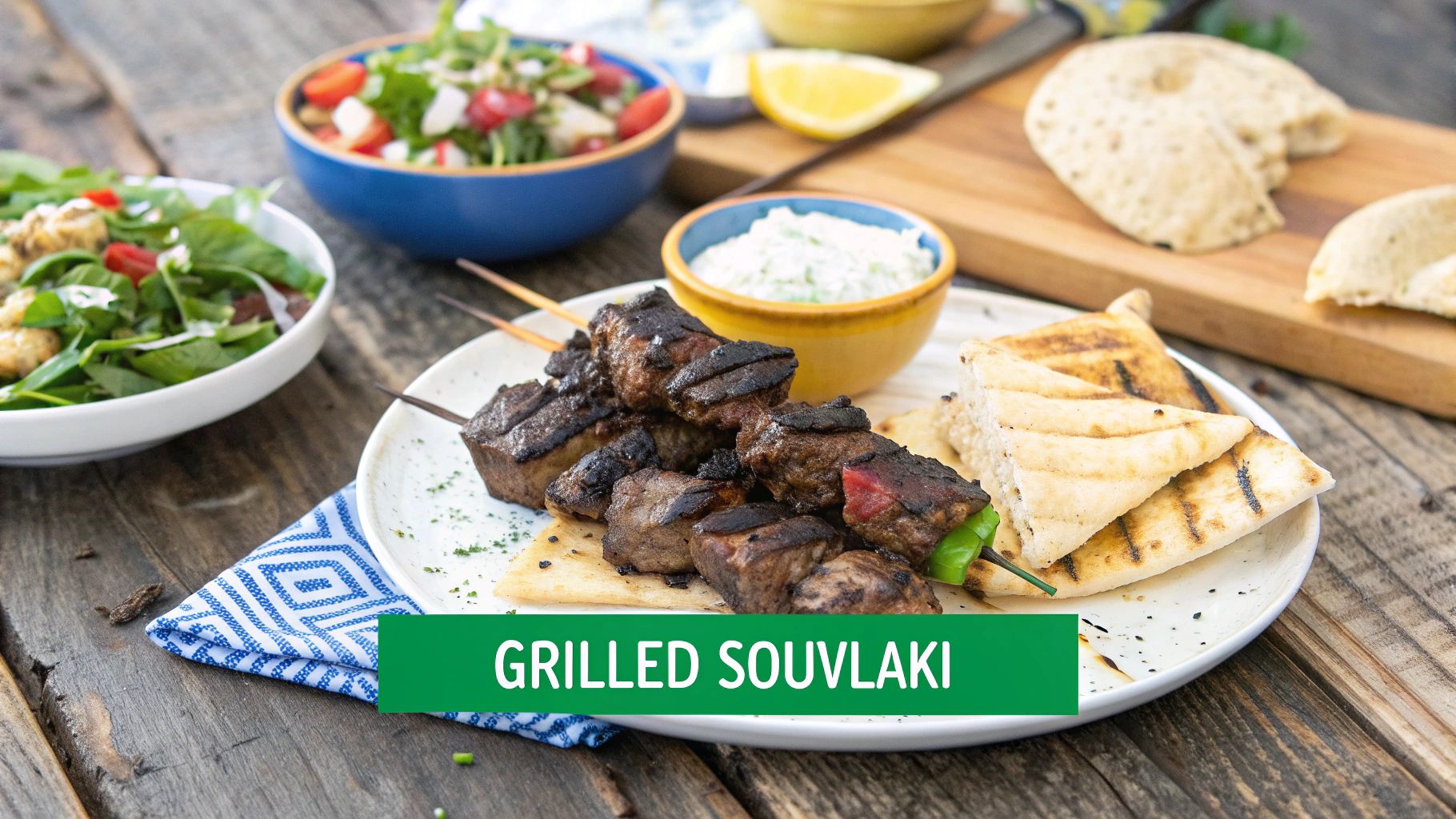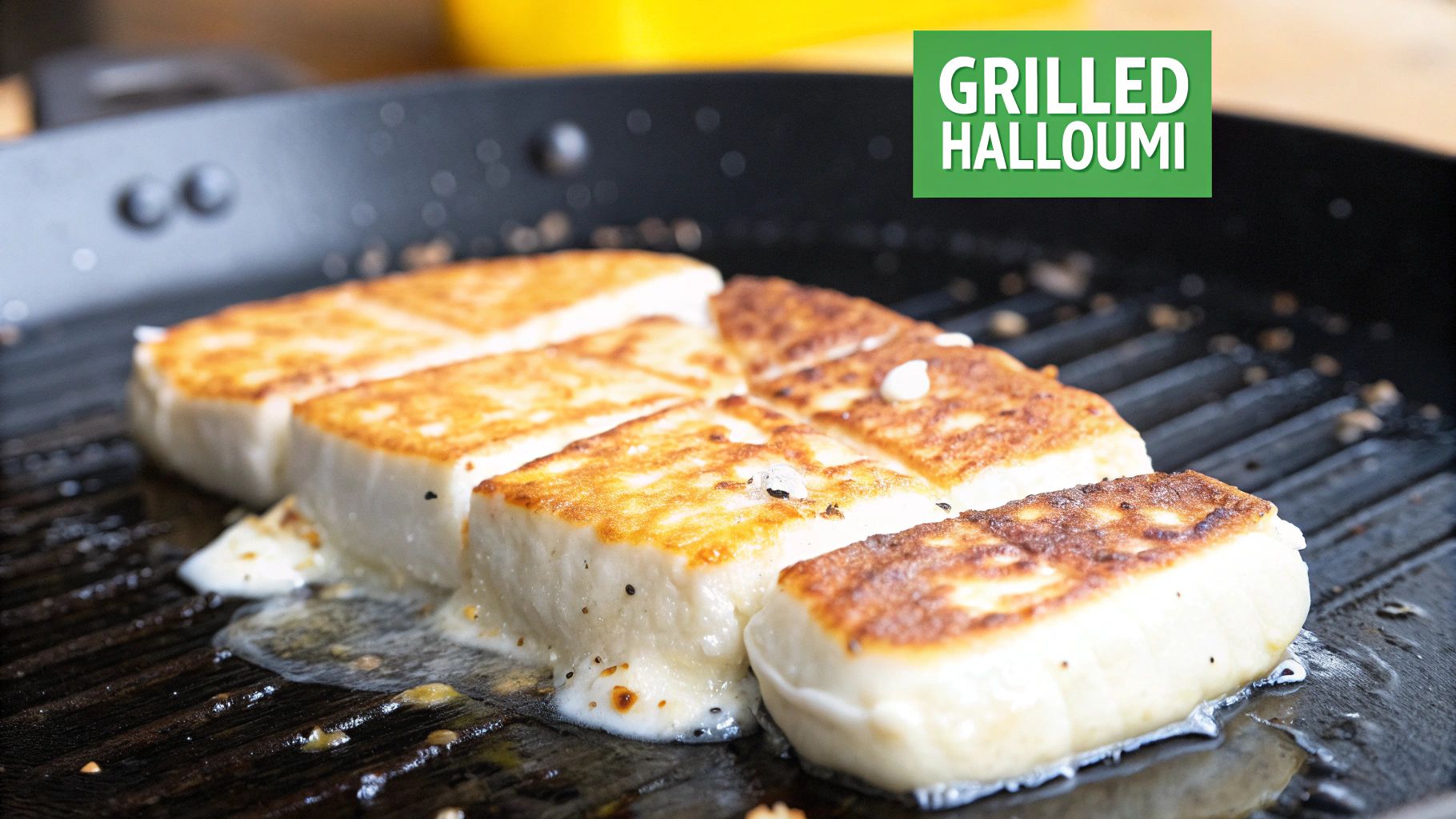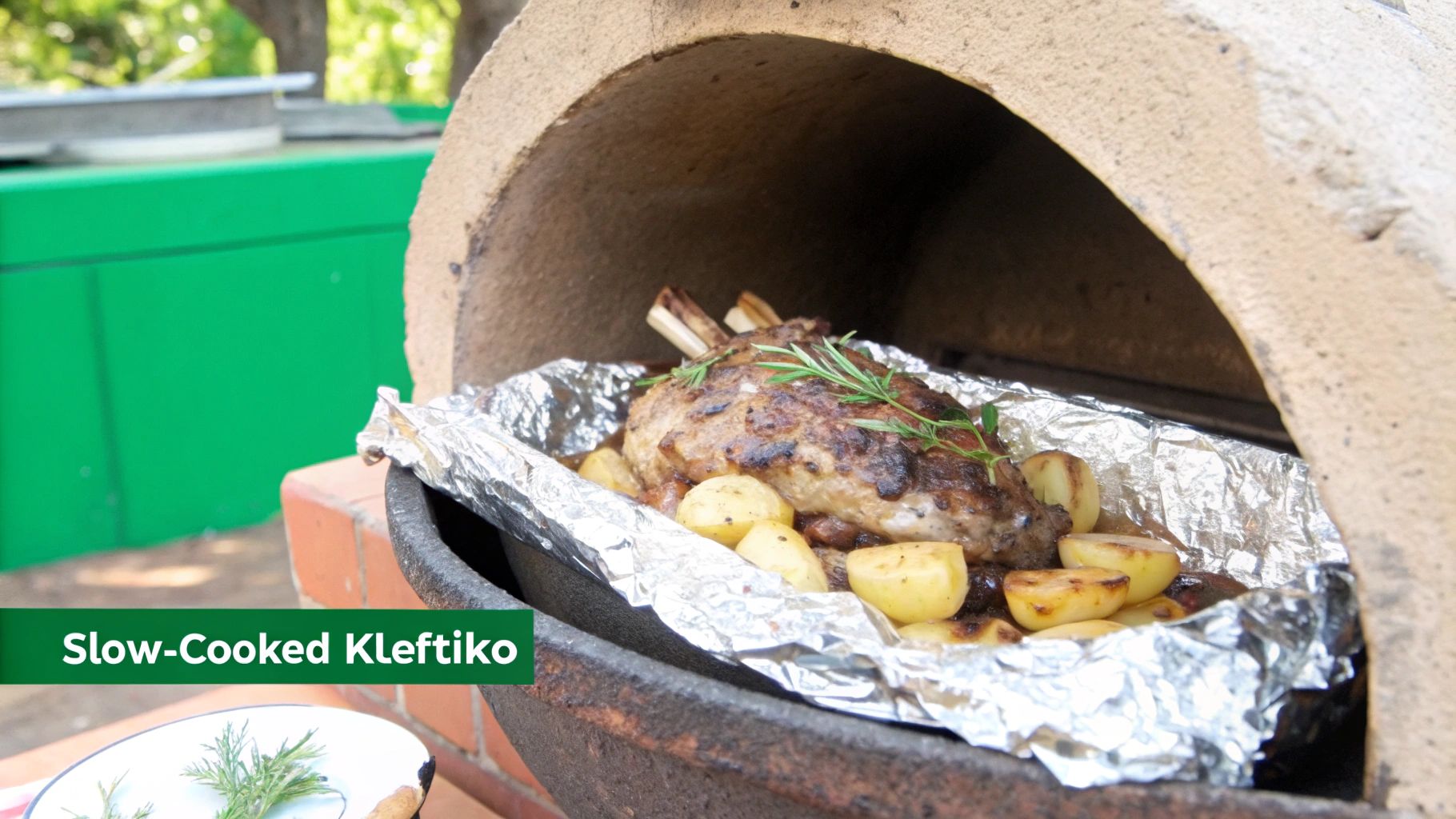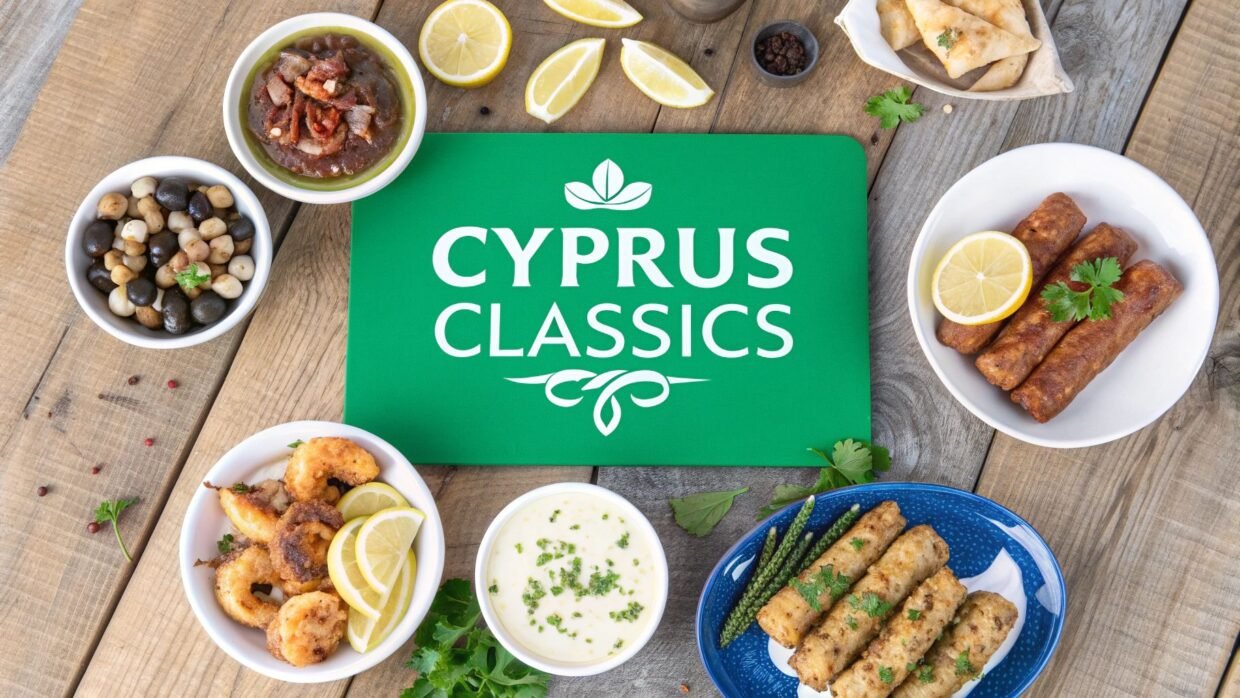Embarking on a culinary journey through Cyprus is to discover the heart of the Mediterranean itself. The island's cuisine is a rich tapestry woven from Greek, Turkish, and Middle Eastern influences, shaped by centuries of history and a sun-drenched landscape. This guide is your definitive map to the most authentic and unmissable traditional food in Cyprus, moving beyond generic tourist menus to uncover the true flavours cherished by locals. We will explore the island's most iconic dishes, from the sizzling charcoal-grilled souvlaki to the slow-cooked, tender lamb kleftiko.
You will learn not just what to eat, but how and where to experience these dishes at their best. We will detail the unique ingredients, cooking methods, and cultural significance behind each plate. Whether you're planning a trip or simply wish to understand the island's gastronomic soul, this list provides a practical and detailed rundown of essential Cypriot food. Prepare to dive into a world of grilled halloumi, aromatic moussaka, and sprawling mezze platters that define the unforgettable taste of Cyprus. This isn't just a list; it's a curated itinerary for your palate, ensuring you savour every moment of your culinary exploration.
1. Souvlaki
No exploration of traditional food in Cyprus is complete without indulging in Souvlaki, the island’s undisputed national dish. While similar to its Greek counterpart, Cypriot souvlaki stands out with its generously sized chunks of meat and unique presentation. It consists of small, succulent pieces of meat, typically pork or chicken, marinated and then skewered before being grilled to perfection over hot charcoal, imparting a distinctive smoky flavour.

The classic way to enjoy this dish is stuffed inside a large, fluffy Cypriot pita bread. Unlike the Greek pocketless flatbread, the Cypriot version is oval and opens up to create a pouch. This is then filled not only with the grilled meat but also with a fresh, finely chopped salad of cucumber, tomatoes, white cabbage, and parsley. It's a full, satisfying meal in one convenient package.
How to Enjoy Souvlaki Like a Local
To truly savour this Cypriot staple, follow a few simple tips for the best experience. The quality of souvlaki can be found all over the island, from bustling urban eateries to quiet village tavernas.
- Try a "Mix": Can't decide between pork and chicken? Order a "mix" which often includes souvlaki alongside sheftalia, a traditional Cypriot sausage made of minced pork, onion, and parsley, wrapped in caul fat and grilled.
- Freshness is Key: Souvlaki is at its absolute best when eaten immediately after it comes off the grill. The meat is tender and juicy, and the pita is warm and soft.
- Balance Your Meal: While the pita is often packed with salad, don't hesitate to ask for extra. The fresh vegetables provide a crisp, refreshing contrast to the rich, savoury meat.
- The Perfect Pairing: For the ultimate Cypriot experience, pair your souvlaki with a cold, local beer like KEO or Leon.
You'll find fantastic souvlaki spots everywhere, from dedicated takeaway shops like Pork n' Roll in Nicosia to traditional tavernas in the Troodos Mountains, where family recipes have been passed down for generations. It’s a versatile dish that serves as both a quick, delicious lunch and a cornerstone of a larger meze feast.
2. Halloumi Cheese
A true icon of the island, Halloumi is arguably Cyprus's most famous culinary export. This unique, semi-hard, unripened cheese is traditionally made from a mixture of goat's and sheep's milk, giving it a distinctively layered texture and salty flavour. Its most remarkable characteristic is its high melting point, which allows it to be grilled or fried to a perfect golden-brown without losing its shape, resulting in a delightfully squeaky bite.

While now available in supermarkets worldwide, tasting authentic, village-made Halloumi in its homeland is an essential part of experiencing traditional food in Cyprus. Whether served simply grilled as part of a meze platter, fried alongside eggs for breakfast, or even enjoyed fresh, its versatile nature makes it a beloved staple in Cypriot households. Its rich, savoury taste is a testament to the island's deep-rooted cheese-making traditions.
How to Enjoy Halloumi Like a Local
To appreciate Halloumi at its finest, embrace the traditional ways it's served across the island. From dedicated producers in the Pitsillia region to the menus of the best restaurants in Cyprus, you’ll find this cheese prepared with pride.
- Go for the Classic Pairing: During the hot summer months, Cypriots love to eat slices of cool, fresh Halloumi with sweet, juicy watermelon. The combination of salty and sweet is incredibly refreshing.
- Grill it Right: For the perfect grilled Halloumi, slice it into 1cm-thick pieces and place it on a medium-hot grill or in a dry non-stick pan. Cook for a few minutes on each side until it develops a beautiful golden crust.
- Serve Immediately: Grilled or fried Halloumi is best enjoyed hot, straight from the pan. This is when its texture is at its peak, with a crispy exterior giving way to a soft, slightly melted centre.
- Try it in a Sandwich: A popular snack is a "lountza-halloumi" sandwich, where grilled Halloumi is paired with slices of smoked pork loin inside a warm pita or bread roll.
3. Kleftiko
Kleftiko is more than just a dish; it’s a taste of Cypriot history served on a plate. This iconic meal features lamb, or occasionally goat, slow-cooked for hours with potatoes, onions, and fragrant herbs like bay leaves and oregano. The name, which translates to ‘stolen meat’, harks back to the days of bandits who would cook stolen livestock in sealed, underground clay ovens to avoid being discovered by the smoke. This slow-cooking method makes the meat incredibly tender, literally falling off the bone.

The magic of Kleftiko lies in its preparation. The meat is traditionally marinated in olive oil, lemon juice, garlic, and herbs before being wrapped tightly in parchment paper or foil. This creates a parcel that traps all the steam and juices, allowing the lamb and potatoes to braise in their own flavourful liquids. The result is a deeply savoury, aromatic, and moist dish that stands as a centrepiece at Sunday family dinners, weddings, and Easter feasts across the island.
How to Enjoy Kleftiko Like a Local
To truly appreciate this cornerstone of traditional food in Cyprus, it's best enjoyed in a rustic setting where time-honoured cooking methods are celebrated. You'll find it on the menu of almost every traditional taverna.
- Choose the Right Cut: While any cut can be used, lamb shoulder or leg on the bone provides the best flavour and tenderness. The bone adds richness to the cooking juices.
- Patience is a Virtue: The key to perfect Kleftiko is not peeking. Do not open the foil or parchment parcel during its long, slow bake, as this will let the essential steam escape.
- Let It Rest: Once out of the oven, allow the meat to rest in its parcel for at least 15 minutes before serving. This helps the juices redistribute, ensuring every bite is succulent.
- Savour the Juices: The liquid at the bottom of the parcel is liquid gold. Spoon it over the meat and potatoes or use some crusty village bread to soak it all up.
Kleftiko is a must-try dish, and you can explore some of the best restaurants in Limassol that specialise in this authentic culinary experience. Paired with a simple village salad and a glass of local red wine, it’s a meal you won’t soon forget.
4. Moussaka
A cornerstone of Cypriot and Eastern Mediterranean cuisine, Moussaka is a rich, oven-baked dish that epitomises comfort food. While versions exist across the Balkans and the Middle East, Cypriot moussaka has its own distinct character. It is constructed from luscious layers of sautéed sliced potatoes, aubergine, and a hearty, spiced minced meat sauce, typically made with lamb or beef, and seasoned with cinnamon and other warm spices.
The dish is crowned with a thick, velvety layer of béchamel sauce, which is baked until it turns a beautiful golden-brown. Often prepared in large trays, it’s a popular choice for family gatherings and Sunday lunches, embodying the spirit of communal dining. This isn't just a meal; it's a celebrated part of the traditional food in Cyprus and a true labour of love.
How to Enjoy Moussaka Like a Local
To fully appreciate this classic dish, a few local customs can enhance the experience. You can find it in nearly every traditional taverna across the island, from the coastal cities of Paphos and Limassol to quaint mountain villages.
- Patience is a Virtue: Moussaka is at its best when allowed to rest for at least 20-30 minutes after coming out of the oven. This allows the layers to set, making for a cleaner slice and enabling the flavours to meld together perfectly.
- Embrace Simplicity: A well-made moussaka is a complete meal in itself. It is rich and filling, so it’s best served simply with a crisp village salad to provide a fresh, acidic contrast to its creaminess.
- Seek Authenticity: While widely available, the best versions are often found in family-run tavernas where the recipe has been perfected over generations. Don't be shy about asking for the "dish of the day," as it's often freshly prepared moussaka.
- Wine Pairing: Complement the rich flavours of the moussaka with a glass of local Cypriot red wine. A robust Maratheftiko grape varietal is an excellent choice to stand up to the dish’s complexity.
Whether you're enjoying it as the main course in a bustling Limassol restaurant or as part of a larger meze spread, moussaka offers a deeply satisfying and authentic taste of Cyprus that is both hearty and delicious.
5. Afelia
Delving into the heart of Cypriot home cooking, Afelia is a rustic and aromatic pork dish that truly captures the island's unique flavour profile. This traditional food in Cyprus is defined by its two core ingredients: red wine and crushed coriander seeds. Cubes of tender pork are first marinated and then slow-cooked in a rich sauce made from these elements, creating a dish that is deeply savoury, fragrant, and utterly distinctive. It's a testament to the Cypriot culinary tradition of using simple, bold ingredients to create unforgettable meals.
Unlike the grilled specialities that often dominate menus, Afelia is a stew, showcasing a different side of the island's cuisine. The slow-cooking process allows the pork to become incredibly tender, almost melting in the mouth, while the wine reduces to a glossy, flavour-packed sauce. The pervasive aroma of coriander is what makes Afelia unmistakably Cypriot, as the spice is used much more prominently here than in neighbouring Greek cooking. It's typically served with pourgouri (bulgur pilaf) or potatoes, which soak up the delicious sauce.
How to Enjoy Afelia Like a Local
To fully appreciate this comforting classic, look for it in places that prize authentic, slow-cooked dishes. It's a staple in village tavernas and a highlight of a comprehensive meze spread.
- Fresh Coriander is a Must: The key to an exceptional Afelia is the use of freshly crushed whole coriander seeds. This releases a much more potent and complex aroma than pre-ground powder.
- The Longer, The Better: A proper marinade is crucial. The pork should be left to soak in the wine and coriander for at least a few hours, or ideally overnight, to fully absorb the flavours.
- Perfect Accompaniments: Enjoy Afelia with a side of creamy yoghurt to balance the richness of the sauce. The traditional pairing is pourgouri, but it's also wonderful with fluffy rice or chunky, hand-cut chips.
- Find it in the Villages: While available in cities, the best Afelia is often found in the mountain villages of the Troodos region. Here, family-run tavernas cook the dish with time-honoured recipes, offering a truly authentic taste of Cypriot culinary heritage.
6. Mezze
More than just a meal, Mezze is a quintessential Cypriot dining experience and a vibrant celebration of the island's culinary diversity. It isn’t a single dish, but rather a grand procession of small plates, typically numbering between 15 to 30, that are shared amongst the table. This social way of eating embodies the Cypriot spirit of hospitality and showcases the very best of traditional food in Cyprus, from fresh dips and salads to grilled meats and seafood.
The feast begins with cold appetisers like tahini, hummus, and talattouri (a mint and yoghurt dip), served with warm pita bread and a village salad. This is followed by a succession of hot dishes, including grilled halloumi, lountza (smoked pork loin), snails in tomato sauce, and various vegetable dishes. The meal culminates in a final wave of grilled meats, such as souvlaki, sheftalia, and lamb chops, ensuring no one leaves the table hungry.
How to Enjoy Mezze Like a Local
Embarking on a Mezze journey requires strategy and an empty stomach. You'll find this fantastic offering in traditional tavernas across the island, from the historic streets of Nicosia to seaside restaurants in Limassol.
- Pace Yourself: The biggest mistake is filling up on the initial bread and dips. The dishes arrive in waves, so eat slowly and save room for the main grilled courses that arrive last.
- Share Everything: Mezze is designed for sharing. It's a communal experience, so be prepared to pass plates around the table and try a little bit of everything.
- Leave Room for the Grand Finale: Just when you think you are full, the heartiest meat dishes will be served. These are often considered the highlight, so ensure you have space for them.
- The Perfect Pairing: A Mezze is beautifully complemented by local Cypriot wine. The variety of dishes pairs well with everything from a crisp Xynisteri white to a robust Maratheftiko red. Exploring the island’s vineyards can be a great way to discover your favourite pairing; you can explore Cyprus wine tours to enhance your culinary adventure.
7. Koupepia (Stuffed Vine Leaves)
A true labour of love in Cypriot cuisine, Koupepia are delicate parcels of flavour that represent the heart of family-style cooking on the island. These tender vine leaves are carefully stuffed with a savoury mixture of minced meat (traditionally pork or beef), long-grain rice, fresh tomatoes, onions, and a fragrant blend of herbs like mint and parsley. They are then gently simmered in a light, lemony broth until incredibly tender.
Often confused with Greek dolmades, Cypriot koupepia are distinguished by their use of tomato in the filling and cooking liquid, giving them a slightly warmer, richer flavour profile. Preparing koupepia is a time-honoured tradition, often a social activity where families gather to roll them for special occasions like Easter, weddings, and village festivals. Their presence on a meze platter signals a truly authentic dining experience.
How to Enjoy Koupepia Like a Local
To fully appreciate this classic dish, which is a cornerstone of traditional food in Cyprus, it’s best enjoyed as part of a larger meal, allowing its subtle flavours to shine.
- Serve Warm, Not Hot: Koupepia are best served warm, often with a generous squeeze of fresh lemon juice and a dollop of thick Greek-style yoghurt to complement the rich filling.
- Look for Freshness: The best koupepia are made with fresh, young vine leaves, which are softer and more flavourful than the brined variety. If you're visiting in late spring, you might be lucky enough to try some made with leaves picked that day.
- Patience is a Virtue: This dish is all about slow cooking. A well-made koupepia will be so tender that it almost melts in your mouth, with the rice and meat filling perfectly cooked and succulent.
- The Perfect Pairing: Enjoy koupepia alongside other meze dishes. They pair beautifully with a crisp Cypriot white wine, such as a Xynisteri, whose acidity cuts through the richness of the filling.
You will find exceptional koupepia at family-run tavernas across Cyprus, from the coastal towns of Paphos and Limassol to the mountain villages where recipes have been cherished for generations. They are a must-try for anyone seeking an authentic taste of the island's culinary heritage.
Traditional Cypriot Foods: Key Characteristics Comparison
| Item | Implementation Complexity 🔄 | Resource Requirements ⚡ | Expected Outcomes 📊 | Ideal Use Cases 💡 | Key Advantages ⭐ |
|---|---|---|---|---|---|
| Souvlaki | Low – straightforward grilling | Moderate – charcoal grill, meats | Quick, filling, protein-rich meal | Casual street food, quick meals | Convenient, affordable, high protein |
| Halloumi Cheese | Low – simple grilling/frying | Low – quality cheese needed | Versatile, flavorful side or snack | Grilling, salads, vegetarian options | Unique texture, versatile, long shelf life |
| Kleftiko | High – slow cooking, careful wrapping | Moderate to high – lamb, oven | Tender, flavorful slow-cooked dish | Special occasions, family gatherings | Rich flavor, one-pot meal |
| Moussaka | High – multiple cooking steps | Moderate – various ingredients | Hearty, layered baked casserole | Large groups, impressive presentations | Complete meal, reheats well |
| Afelia | Moderate – marinating and slow cooking | Low to moderate – pork, spices | Aromatic tender pork dish | Traditional meals, pairing with sides | Distinct coriander flavor, simple prep |
| Mezze | High – many dishes, complex serving | High – variety of ingredients | Social, diverse tasting experience | Social dining, cultural events | Variety, interactive, cultural |
| Koupepia | Very high – labor-intensive rolling | Moderate – vine leaves, meat, rice | Nutritious, impressive presentation | Festive occasions, family traditions | Nutritional balance, make-ahead |
Final Thoughts
Our journey through the rich tapestry of traditional food in Cyprus has revealed far more than just a list of dishes; it has uncovered the very soul of the island, served on a platter. From the smoky, chargrilled perfection of souvlaki enjoyed in a bustling city square to the slow-cooked, tender reverence of kleftiko that falls off the bone, each meal tells a story of history, family, and the island's unique cultural crossroads. We have seen how simple, high-quality ingredients like halloumi cheese can become a global icon, yet still taste best when grilled fresh in its homeland.
The true essence of Cypriot cuisine, however, lies not just in individual dishes but in the philosophy of sharing and abundance, best embodied by the mezze. This is not merely a meal; it is a social ritual, a culinary event that invites you to slow down, connect with your companions, and savour a diverse parade of flavours. Similarly, dishes like moussaka, afelia, and koupepia are a testament to the resourcefulness and creativity of Cypriot home cooking, transforming humble ingredients into deeply comforting and flavourful creations.
Your Culinary Adventure Awaits
As you plan your own exploration of traditional food in Cyprus, we encourage you to move beyond the menu and truly immerse yourself in the experience. Your next steps should be to:
- Seek Authenticity: Venture beyond the main tourist strips. Ask locals for their favourite taverna or find a family-run establishment in a small village to taste recipes passed down through generations.
- Embrace the Mezze: Dedicate at least one evening to a full mezze experience. Arrive with an empty stomach and an open mind, ready to discover new tastes and textures.
- Visit a Local Market: Explore a laiki agora (farmers' market) to see the vibrant, fresh produce that forms the foundation of Cypriot cooking. It's the perfect place to appreciate the quality of the island's ingredients firsthand.
Mastering the landscape of Cypriot food is about more than just satisfying hunger. It's about engaging with a culture that places immense value on hospitality, community, and the joy of a shared meal. By actively seeking out these authentic culinary moments, you will not only eat well but also gain a profound appreciation for the heart of Cyprus. Let every bite be a discovery, a connection to the island’s sun-drenched land and its warm, generous people. Your gastronomic adventure is a pivotal part of any Cypriot journey, promising memories that will linger long after the last plate is cleared.
Ready to turn these culinary dreams into reality? SayCyprus specialises in curating bespoke travel experiences, connecting you with authentic local tours, trusted restaurant recommendations, and unique cultural activities. Plan your perfect gastronomic journey with us at SayCyprus.












